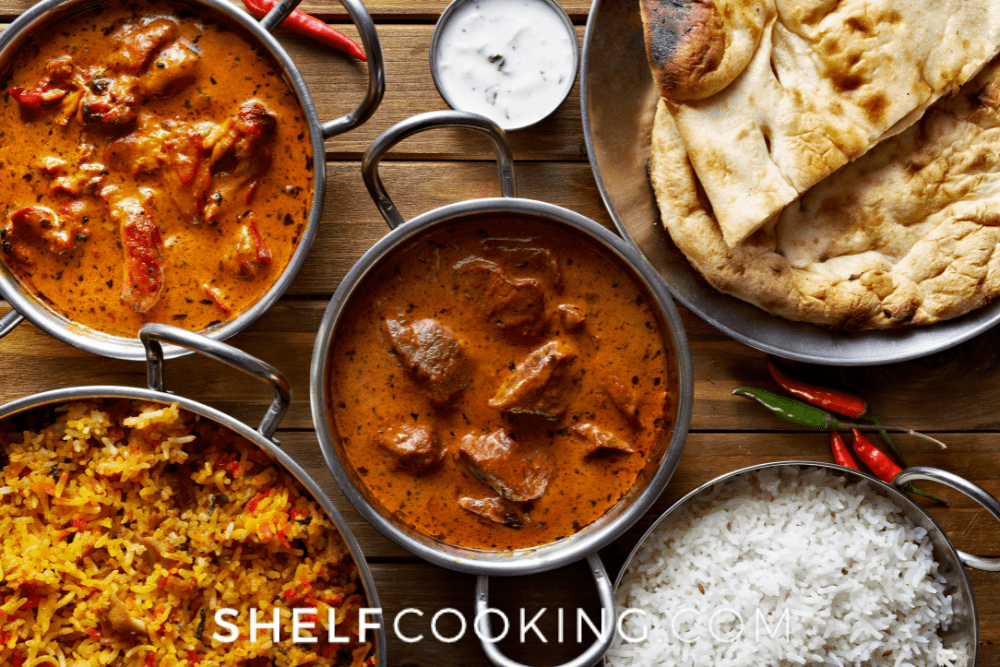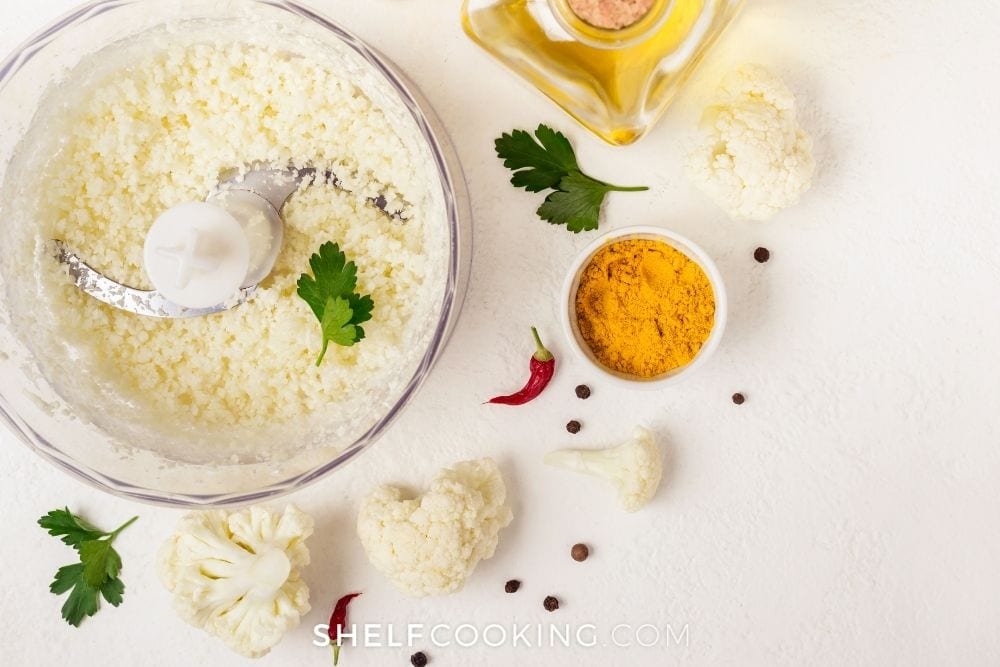In this customizable curry recipe, you have the freedom to choose your preferred meats, vegetables, and flavor profiles based on what you like AND what you already have on hand! That’s the Shelf Cooking way!

When it comes to global cuisine, few dishes are as diverse and delicious as curry. Originating in India, curry has evolved into countless variations and has so many unique options! If you haven't tried curry yet, don't be intimidated. Think of it like a soup! A soup packed with bold flavors. The sauce typically includes spices like turmeric, cumin, coriander, cardamom, cinnamon, and cloves. But as you'll find out in this recipe, there really are dozens of ways to prepare your own curry which is exactly what we love around here in our Shelf Cooking community!
CHOOSE-YOUR-OWN-ADVENTURE STYLE CURRY RECIPE
THE BASE:
You're list of options for meats, veggies, and flavor profiles will come next. But first, we are starting off with a base to build on from here.
- 2 tablespoons vegetable oil
- 3 cloves garlic, minced
- 1-inch piece of ginger, minced
- 2 tablespoons curry powder (adjust to taste)
- 1 teaspoon ground cumin
- 1 teaspoon ground coriander
- 1 teaspoon paprika
- Salt and pepper to taste
- 1 (14-ounce) can diced tomatoes
- 1 (14-ounce) can coconut milk
- 1 cup chicken or vegetable broth

THE MEAT:
- Chicken: Chicken is one of the most popular choices for curry. It's versatile and can be used in a wide range of curry styles, from creamy butter chicken to spicy chicken vindaloo.
- Beef: Beef is often used in hearty curries like beef rendang or massaman curry. It becomes tender and flavorful when slow-cooked in curry sauces.
- Lamb: Lamb has a robust flavor that pairs wonderfully with spices. Lamb curry dishes, such as Rogan Josh, are favorites in many cuisines.
- Pork: Pork curries are enjoyed in various parts of the world, offering a slightly sweet and savory profile. Try a Thai red curry with pork for a delicious option.
- Shrimp: Seafood lovers can enjoy shrimp curries, which are known for their delicate and sweet flavor. Coconut-based shrimp curries are especially popular.
- Fish: Firm fish like cod or salmon can be used in curry. Fish curry is common in coastal regions and offers a lighter, more delicate taste.
- Tofu: Tofu is an excellent choice for vegetarians and vegans. It soaks up the flavors of the curry sauce and provides a hearty, protein-rich option.
- Duck: Duck curry is a luxurious option, often found in Thai cuisine. The rich and flavorful meat pairs well with spicy and aromatic curry sauces.
- Turkey: Turkey can be used in curry as a lean and healthy alternative to other meats. It's particularly good in lighter curries with lots of vegetables.
- *Vegetarian Option*: Chickpeas or Garbanzo Beans.
It's best to pre-cut your protein into cubes, and sauté in a saucepan until cooked to a safe temperature before adding into your curry sauce with your other vegetables. Ultimately, the choice of meat is a matter of personal preference, and you can experiment with different options to create the perfect curry for your palate.

THE VEGGIES:
- Onions: Onions are often the base of curry recipes, adding a sweet and savory depth of flavor.
- Garlic: Garlic adds a delightful pungency and aroma to curries.
- Ginger: Fresh ginger is commonly used in many curry recipes for its zesty and spicy notes.
- Bell Peppers: Bell peppers come in various colors and add sweetness and a pleasant crunch to curries.
- Tomatoes: Tomatoes can be used in various forms, including fresh, canned, or as tomato paste, to add acidity and body to the sauce.
- Potatoes: Potatoes add a hearty, starchy element to curries, making them more filling.
- Carrots: Carrots provide a subtle sweetness and a satisfying crunch.
- Eggplant: Eggplant can absorb the flavors of the curry and has a creamy texture when cooked.
- Spinach: Spinach wilts down beautifully in curry, adding a vibrant green color and a mild, earthy flavor.
- Zucchini: Zucchini adds a tender texture and a mild, slightly sweet taste to curry.
- Cauliflower: Cauliflower florets soak up the curry sauce and offer a satisfying bite.
- Broccoli: Broccoli adds a touch of bitterness and a slight crunch to curry dishes.
- Mushrooms: Mushrooms, such as button or cremini, bring an earthy, umami-rich flavor to curries.
- Green Beans: Green beans retain their crispness and add a fresh, slightly sweet note.
- Peas: Peas are a classic addition to many curry recipes, contributing sweetness and a pop of color.
- Butternut Squash: Butternut squash lends natural sweetness and a velvety texture to curries.
- Okra: Okra can be used to thicken curry sauces and has a unique, slightly slimy texture when cooked.
- Kale: Kale can be added for a hearty, leafy green option with a slightly bitter taste.
- Cabbage: Cabbage adds crunch and can be finely shredded or chopped for curries.
- Bamboo Shoots: Commonly used in Thai and Southeast Asian curries, bamboo shoots offer a subtle earthy flavor and a tender bite.
The best part of a choose-your-own-adventure curry recipe is just selecting the handful of vegetables that sound good to you, are in season, and are something you have readily available! Your curry recipe can have 1, 2, 3 of these veggie add-ins, or as many as you please!

FLAVOR PROFILE MODIFICATIONS:
Here are some modifications that you can make to your base/sauce to cater to your preferences!
- Extra Creamy: Add 1/2 cup coconut milk
- Extra Spicy: Add chili powder or red pepper flakes to taste
- Extra Tangy: Add 2 tablespoons lemon juice
- Extra Sweet: Add 2 tablespoons honey or brown sugar
- Extra Smoky: Add 1 teaspoon smoked paprika
- Extra Nutty: Add 1/4 cup crushed peanuts, cashews or almonds as a topping after cooking

How To Serve Your Curry Dish
You can absolutely serve your curry in a bowl, like a soup. However it is popular to serve with some kind of other carbohydrate to stretch the meal and also add a palate-cleanser to calm the spice! Here are some popular ways to serve a curry dish:
- Over Rice: Serving curry over steamed rice is one of the most common and delicious ways to enjoy it. The rice helps balance the flavors and absorbs the flavorful sauce. Basmati rice is a popular choice for Indian curries, while jasmine rice pairs well with Thai curries.
- With Bread: In many cultures, curry is served with various types of bread. Some options include:
- Naan: A soft, leavened Indian flatbread that's perfect for scooping up curry.
- Roti: Another Indian flatbread, which is thinner and lighter than naan.
- Chapati: A staple in Indian cuisine, chapati is a simple, unleavened flatbread.
- With Noodles: In Asian cuisines, curries are often served with noodles. For example, Thai curries can be served with rice noodles, and Japanese curry is traditionally served with udon or ramen noodles.
- In a Bowl: Some curries, like Japanese or Thai curry, are served in a bowl as a soup or stew. This is a great way to enjoy the flavors of the curry and its ingredients without the need for rice or bread.
- With Pickles and Chutneys: Many curry dishes are complemented with pickles, chutneys, or relishes that provide contrasting flavors and textures. Mango chutney, lime pickle, and raita are popular accompaniments in Indian cuisine.
- With Yogurt: A dollop of plain yogurt or Greek yogurt on top of your curry can add creaminess and help cool down spicy curries.
- Over Couscous or Quinoa: If you're looking for a healthier alternative to rice, you can serve curry over couscous or quinoa for a nutritious and filling meal.
There you have it – dozens of ways to create and serve your very own international cuisine! Take this choose-you-own-adventure curry recipe and whip up something of your own. We'd love for you to share your creation with us over on social media! Tag @ShelfCooking on Instagram!

You'll love these other great blog posts!
